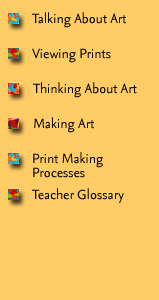
 |
||||||||
|
|
||||||||
|
|
|
|
|
|
|
|
|
|
|
|
||||||||

|
|
Home > Learning
Resources > Teacher's Packet
> Print Making
Processes > Planographic ProcessesPlanographic ProcessesThe primary Planographic process is lithography - Lithography was
invented in 1798, and became popular by the end of the 19th
century. The image is drawn using either oil-based lithographic crayons or a
greasy material called tusche, onto a polished piece of limestone or a
specially prepared zinc or aluminum plate. The surface is then wiped clean
with a chemical solution which causes the areas covered by the image to
attract the greasy printers’ ink, and the blank areas around the image to
repel the ink and attract water. The surface is then wiped with a solvent,
which dissolves most of the original image except a ghostlike version of the
image which remains “fixed”, or permanently bonded to the surface of the
plate. The entire stone is then wet with water, which is absorbed by the
blank areas, and repelled by the greasy “fixed” areas. A roller is then used
to apply an oil based printers ink of the surface of the plate, which
adheres to the greasy areas of the plate, but is repelled by the wet areas.
The inked plate is then placed onto the bed of a lithographic press, and a
sheet of dampened paper is laid on top. A board is placed on top of the
paper, and the tension plate of the press is lowered, and even pressure is
applied as the rollers of the press are turned. If a lithograph is to
contain more than one color, then separate stones must be used for each. |